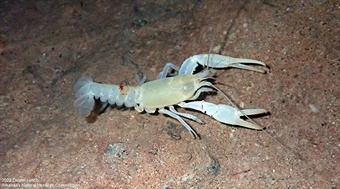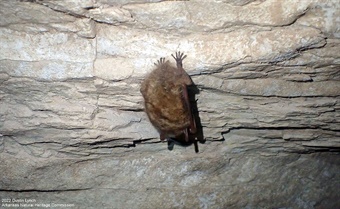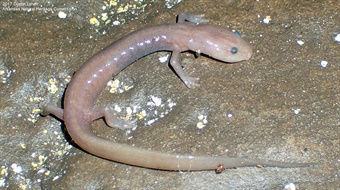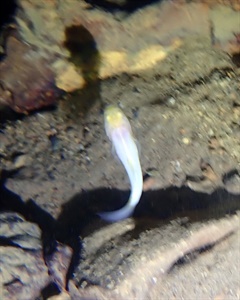Some of the most fascinating aquatic species in Arkansas can be found in our caves, aquifers, and underground streams. These species, which live in a state of perpetual darkness, exhibit a suite of morphological (body structure) adaptations known as troglomorphism, which may include features such as loss of pigment, reduced eyesight or blindness, well-developed tactile sensory organs, and attenuated (smaller) bodies and appendages. These subterranean fauna are divided into two main categories – troglofauna and stygofauna. Troglofauna are associated with terrestrial underground habitats, while stygofauna are associated with aquatic underground habitats.
 These two main categories are further ecologically divided based on how closely they are bound to cave environments. Troglofauna are divided into trogloxenes, troglophiles, and troglobionts. Trogloxenes are cave visitors that may occur sporadically or temporarily in caves and move freely in and out; they do not establish permanent populations underground and lack special adaptations for life underground. Troglophiles can live both in subterranean habitats as well as above-ground habitats. Troglobionts (sometimes called troglobites) are species that spend their entire lives in caves and show the most specialized adaptations to these environments. The corresponding terms for stygofauna are stygoxenes, stygophiles, and stygobionts.
These two main categories are further ecologically divided based on how closely they are bound to cave environments. Troglofauna are divided into trogloxenes, troglophiles, and troglobionts. Trogloxenes are cave visitors that may occur sporadically or temporarily in caves and move freely in and out; they do not establish permanent populations underground and lack special adaptations for life underground. Troglophiles can live both in subterranean habitats as well as above-ground habitats. Troglobionts (sometimes called troglobites) are species that spend their entire lives in caves and show the most specialized adaptations to these environments. The corresponding terms for stygofauna are stygoxenes, stygophiles, and stygobionts.
 In regard to temperature, light, humidity, and other factors, cave environments are more constant than surface environments. Cave food webs are rather simple compared to those on the surface due to the overall lack of organic material and energy available to cave organisms. Plants require sunlight to photosynthesize and are consequently absent from these environments. The species that live in caves depend instead on the occasional influx of organic debris (leaves, twigs, etc.) and the droppings of animals that feed outside of caves, such as bats, in order to survive. Cave ecosystems receive only a fraction of the energy input of those on the surface. As a result of living under these constraints, troglobionts and stygobionts tend to show physiological adaptations such as reduced metabolism, lower reproductive potential, and increased longevity. They also tend to have much smaller population sizes than surface-dwelling species.
In regard to temperature, light, humidity, and other factors, cave environments are more constant than surface environments. Cave food webs are rather simple compared to those on the surface due to the overall lack of organic material and energy available to cave organisms. Plants require sunlight to photosynthesize and are consequently absent from these environments. The species that live in caves depend instead on the occasional influx of organic debris (leaves, twigs, etc.) and the droppings of animals that feed outside of caves, such as bats, in order to survive. Cave ecosystems receive only a fraction of the energy input of those on the surface. As a result of living under these constraints, troglobionts and stygobionts tend to show physiological adaptations such as reduced metabolism, lower reproductive potential, and increased longevity. They also tend to have much smaller population sizes than surface-dwelling species.
 Unfortunately, troglobionts and stygobionts are also some of our most imperiled species. The life history traits that make them well-adapted to low-energy, fragile subterranean environments also make them inherently vulnerable to threats such as environmental disturbances or competition and predation from invading surface species. Cave ecosystems are also particularly vulnerable to disturbance due to the narrow range of specific environmental conditions in which they occur. Slight changes in water quality or quantity due to pollution, agricultural or urban development, or hydrologic alteration can have severe impacts on species so highly adapted to such specific and constant environmental conditions. As a result, most cave fauna in Arkansas are considered Elements of Concern by the Arkansas Natural Heritage Commission (ANHC); we work to track and monitor all known populations of these species. Furthermore, several of these species are rare enough to be federally protected by the U.S. Fish and Wildlife Service (USFWS) under the Endangered Species Act (ESA). Species protected by the ESA are designated as either endangered, i.e. at risk of extinction, or threatened, i.e. likely to become endangered within the foreseeable future.
Unfortunately, troglobionts and stygobionts are also some of our most imperiled species. The life history traits that make them well-adapted to low-energy, fragile subterranean environments also make them inherently vulnerable to threats such as environmental disturbances or competition and predation from invading surface species. Cave ecosystems are also particularly vulnerable to disturbance due to the narrow range of specific environmental conditions in which they occur. Slight changes in water quality or quantity due to pollution, agricultural or urban development, or hydrologic alteration can have severe impacts on species so highly adapted to such specific and constant environmental conditions. As a result, most cave fauna in Arkansas are considered Elements of Concern by the Arkansas Natural Heritage Commission (ANHC); we work to track and monitor all known populations of these species. Furthermore, several of these species are rare enough to be federally protected by the U.S. Fish and Wildlife Service (USFWS) under the Endangered Species Act (ESA). Species protected by the ESA are designated as either endangered, i.e. at risk of extinction, or threatened, i.e. likely to become endangered within the foreseeable future.
Photos:
Photo 1 — The endangered Benton County Cave Crayfish (Cambarus aculabrum), a stygobiont, photographed at Logan Cave National Wildlife Refuge by Dustin Lynch.
Photo 2 — Tricolored Bat (Perimyotis subflavus), a trogloxene, at Hell Creek Cave Natural Area. These bats use the cave for hibernation during the winter. Photo by Dustin Lynch.
Photo 3 — A Southern Grotto Salamander (Eurycea braggi) at Slippery Hollow Natural Area. While not federally listed as endangered or threatened, the species is tracked as an S3 (vulnerable) species in Arkansas by the ANHC. Photo by Dustin Lynch.
Main Photo — The federally listed threatened Ozark Cavefish (Troglichthys rosae), a stygobiont. Photo by Dustin Lynch.
 These two main categories are further ecologically divided based on how closely they are bound to cave environments. Troglofauna are divided into trogloxenes, troglophiles, and troglobionts. Trogloxenes are cave visitors that may occur sporadically or temporarily in caves and move freely in and out; they do not establish permanent populations underground and lack special adaptations for life underground. Troglophiles can live both in subterranean habitats as well as above-ground habitats. Troglobionts (sometimes called troglobites) are species that spend their entire lives in caves and show the most specialized adaptations to these environments. The corresponding terms for stygofauna are stygoxenes, stygophiles, and stygobionts.
These two main categories are further ecologically divided based on how closely they are bound to cave environments. Troglofauna are divided into trogloxenes, troglophiles, and troglobionts. Trogloxenes are cave visitors that may occur sporadically or temporarily in caves and move freely in and out; they do not establish permanent populations underground and lack special adaptations for life underground. Troglophiles can live both in subterranean habitats as well as above-ground habitats. Troglobionts (sometimes called troglobites) are species that spend their entire lives in caves and show the most specialized adaptations to these environments. The corresponding terms for stygofauna are stygoxenes, stygophiles, and stygobionts. In regard to temperature, light, humidity, and other factors, cave environments are more constant than surface environments. Cave food webs are rather simple compared to those on the surface due to the overall lack of organic material and energy available to cave organisms. Plants require sunlight to photosynthesize and are consequently absent from these environments. The species that live in caves depend instead on the occasional influx of organic debris (leaves, twigs, etc.) and the droppings of animals that feed outside of caves, such as bats, in order to survive. Cave ecosystems receive only a fraction of the energy input of those on the surface. As a result of living under these constraints, troglobionts and stygobionts tend to show physiological adaptations such as reduced metabolism, lower reproductive potential, and increased longevity. They also tend to have much smaller population sizes than surface-dwelling species.
In regard to temperature, light, humidity, and other factors, cave environments are more constant than surface environments. Cave food webs are rather simple compared to those on the surface due to the overall lack of organic material and energy available to cave organisms. Plants require sunlight to photosynthesize and are consequently absent from these environments. The species that live in caves depend instead on the occasional influx of organic debris (leaves, twigs, etc.) and the droppings of animals that feed outside of caves, such as bats, in order to survive. Cave ecosystems receive only a fraction of the energy input of those on the surface. As a result of living under these constraints, troglobionts and stygobionts tend to show physiological adaptations such as reduced metabolism, lower reproductive potential, and increased longevity. They also tend to have much smaller population sizes than surface-dwelling species. Unfortunately, troglobionts and stygobionts are also some of our most imperiled species. The life history traits that make them well-adapted to low-energy, fragile subterranean environments also make them inherently vulnerable to threats such as environmental disturbances or competition and predation from invading surface species. Cave ecosystems are also particularly vulnerable to disturbance due to the narrow range of specific environmental conditions in which they occur. Slight changes in water quality or quantity due to pollution, agricultural or urban development, or hydrologic alteration can have severe impacts on species so highly adapted to such specific and constant environmental conditions. As a result, most cave fauna in Arkansas are considered Elements of Concern by the Arkansas Natural Heritage Commission (ANHC); we work to track and monitor all known populations of these species. Furthermore, several of these species are rare enough to be federally protected by the U.S. Fish and Wildlife Service (USFWS) under the Endangered Species Act (ESA). Species protected by the ESA are designated as either endangered, i.e. at risk of extinction, or threatened, i.e. likely to become endangered within the foreseeable future.
Unfortunately, troglobionts and stygobionts are also some of our most imperiled species. The life history traits that make them well-adapted to low-energy, fragile subterranean environments also make them inherently vulnerable to threats such as environmental disturbances or competition and predation from invading surface species. Cave ecosystems are also particularly vulnerable to disturbance due to the narrow range of specific environmental conditions in which they occur. Slight changes in water quality or quantity due to pollution, agricultural or urban development, or hydrologic alteration can have severe impacts on species so highly adapted to such specific and constant environmental conditions. As a result, most cave fauna in Arkansas are considered Elements of Concern by the Arkansas Natural Heritage Commission (ANHC); we work to track and monitor all known populations of these species. Furthermore, several of these species are rare enough to be federally protected by the U.S. Fish and Wildlife Service (USFWS) under the Endangered Species Act (ESA). Species protected by the ESA are designated as either endangered, i.e. at risk of extinction, or threatened, i.e. likely to become endangered within the foreseeable future.Photos:
Photo 1 — The endangered Benton County Cave Crayfish (Cambarus aculabrum), a stygobiont, photographed at Logan Cave National Wildlife Refuge by Dustin Lynch.
Photo 2 — Tricolored Bat (Perimyotis subflavus), a trogloxene, at Hell Creek Cave Natural Area. These bats use the cave for hibernation during the winter. Photo by Dustin Lynch.
Photo 3 — A Southern Grotto Salamander (Eurycea braggi) at Slippery Hollow Natural Area. While not federally listed as endangered or threatened, the species is tracked as an S3 (vulnerable) species in Arkansas by the ANHC. Photo by Dustin Lynch.
Main Photo — The federally listed threatened Ozark Cavefish (Troglichthys rosae), a stygobiont. Photo by Dustin Lynch.
